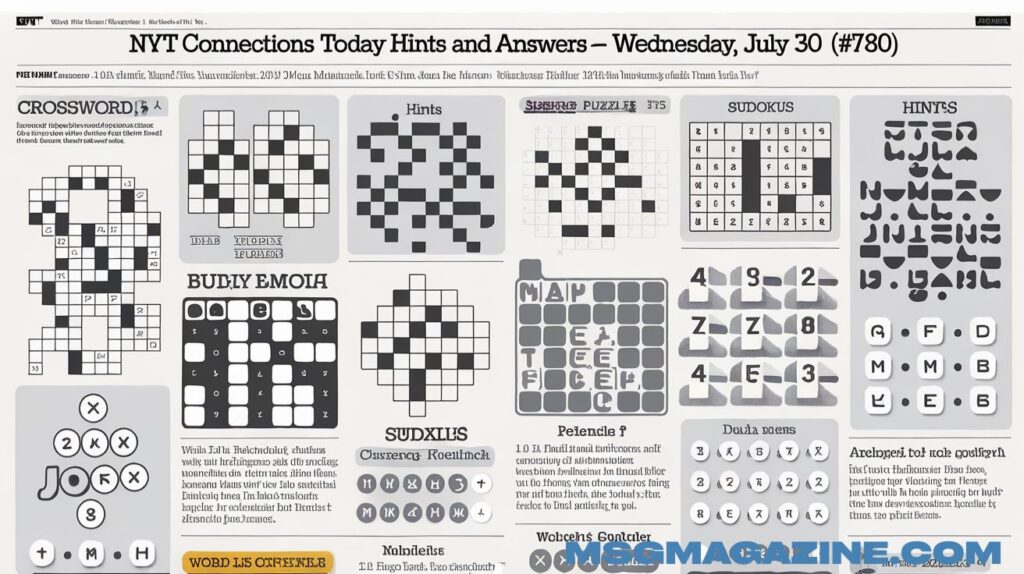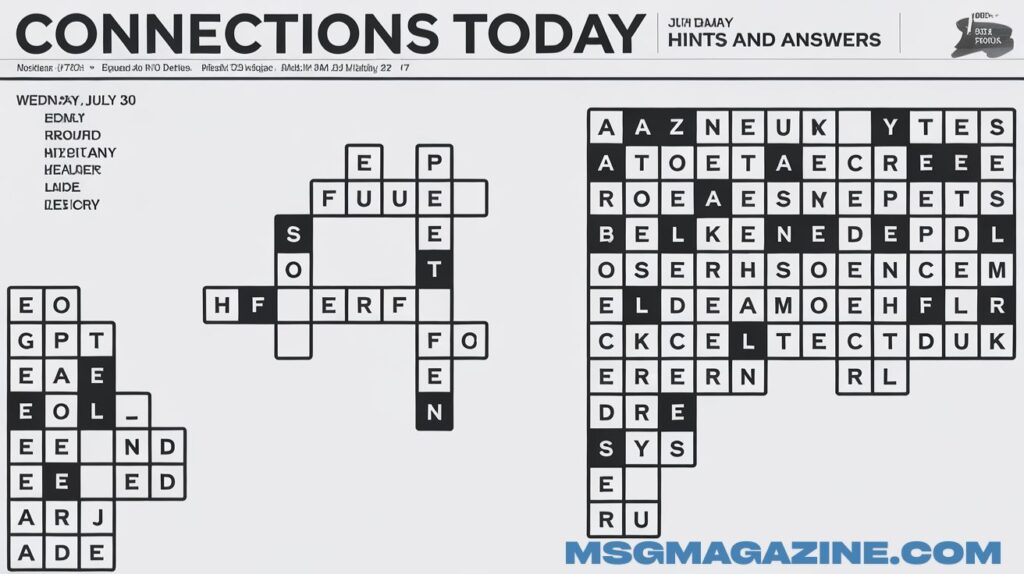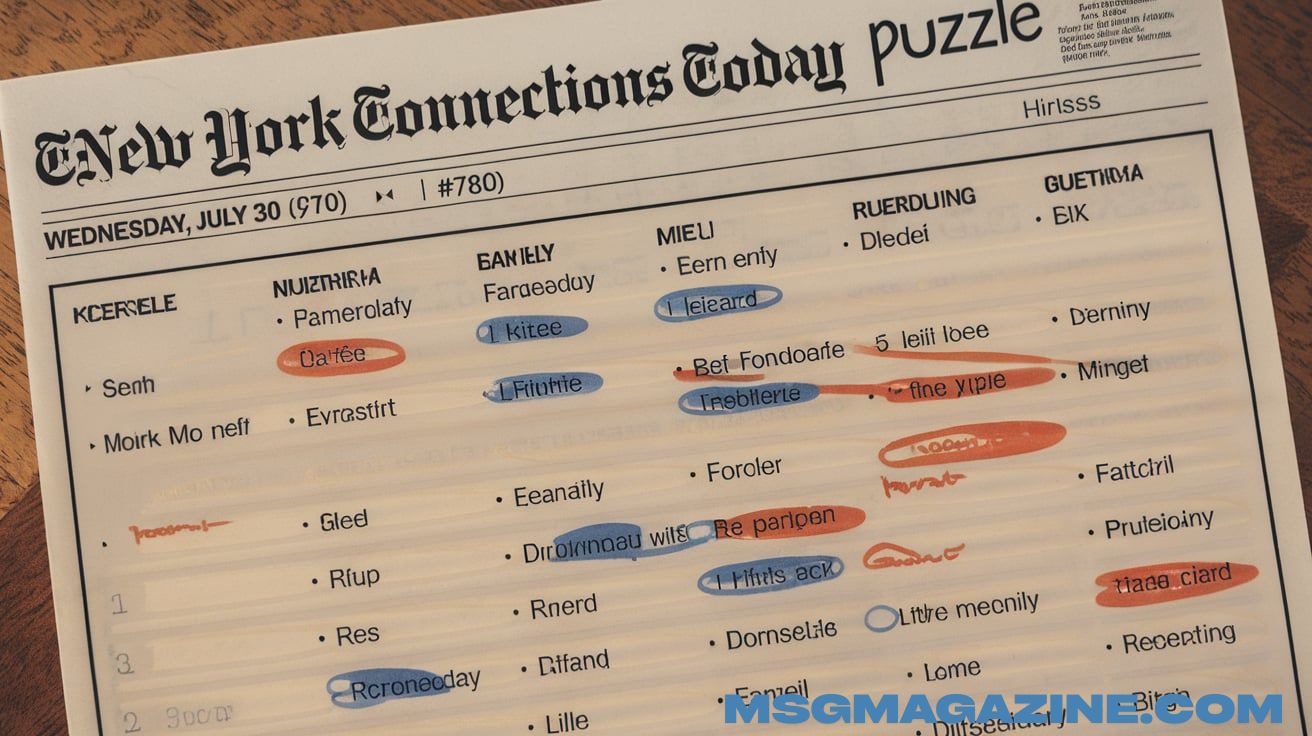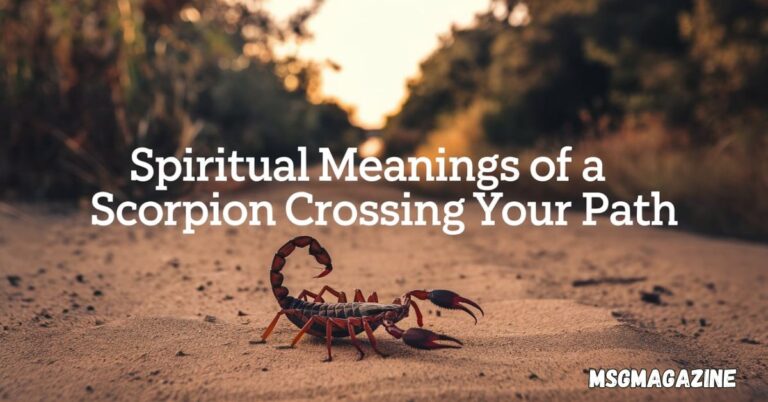If you’re a fan of the NYT Connections puzzle, you know that each day offers a fresh challenge that tests your mind in new ways. For many puzzle lovers in the USA, today’s Connections hint and answer on Wednesday, July 30 (#780) is an exciting opportunity to engage in a daily brain workout.
we will explore how the Connections puzzle works, provide detailed strategies for Connections hint, reveal today’s Connections answers, and give a quick look back at yesterday’s Connections answers. Whether you are a beginner or an experienced player, this guide will deepen your understanding of this popular word puzzle game and improve your puzzle-solving techniques.
Today’s Connections Answer — Hints to Help You Solve It

Understanding how to solve NYT Connections starts with recognizing the unique structure of this daily word puzzle. The game presents 16 words that must be divided into four groups of four. Each group shares a common theme, which can range from clear categories like fruits or colors to more abstract connections involving Homophones, wordplay, or subtle cultural references. This is where your skills in pattern recognition and concept-based reasoning come into play.
If you’re looking for game hints to crack the July 30 puzzle, a great place to start is by identifying the color-coded difficulty levels. The puzzle uses four color groups (yellow, green, blue, purple) to signal how easy or hard each cluster is to find. The yellow group usually contains the easiest connections, often obvious to many players. The green and blue groups increase in difficulty, requiring more nuanced thinking. The purple group is the hardest and often involves abstract or tricky themes that test your puzzle-solving skills deeply.
One of the best strategies for Connections hint is to scan the list of words for obvious word categories. For example, look for items that belong to the same food group, musical terms, or places. Next, check for possible wordplay or Homophones, as these are common in the harder groups. Using this two-step approach can help avoid common mistakes and improve your guessing strategy. Be sure to apply grid analysis and consider multiple meanings of the words.
A case study from July 30’s puzzle illustrates this well. Early in the puzzle, players might notice a clear cluster of musical words. But the real challenge is spotting the group where words have double meanings related to “dates” or “time,” which requires paying attention to abstract clues rather than straightforward categories. This example shows how important it is to use hints effectively while engaging your mind in crossword-style thinking and logic puzzle skills.
Today’s Connections Answers
Now, let’s reveal today’s Connections answers for puzzle #780, breaking them down by category and explaining why they belong together. This will help you understand the deeper reasoning behind the grouping and improve your future puzzle-solving experiences.
| Color Group | Category | Words | Explanation |
| Yellow | Musical Terms | Note, Key, Scale, Solo | These four are related to music basics—terms every player familiar with music will recognize. |
| Green | Dance Movements | Step, Tap, March, Drill | All four words describe types of movement or dance steps, requiring concept-based reasoning. |
| Blue | Fruits | Apple, Fig, Plum, Grape | A straightforward word grouping based on fruit names, an easy category for most players. |
| Purple | Double Meanings of “Date” | Bark, Bass, Jam, Date | This tricky group involves words with multiple meanings linked to “date,” using abstract connections and wordplay. |
The purple group often confuses many players, as the connection is not obvious on the surface. This reflects the increasing complexity of the color-coded difficulty levels. Recognizing that some words have Homophones or abstract meanings is crucial to solving these puzzles.
Using these answers as a guide, try to reflect on your own solving process. Did you start with the easy clusters and work your way to the harder ones? Did you use puzzle-solving techniques like identifying common themes or analyzing word roots? Learning these strategies will help you master future daily challenges and improve your mental fitness.
Yesterday’s Connections Answers
For continuity and better community puzzle solving, it’s helpful to review yesterday’s Connections answers from July 29. Tracking your progress this way sharpens your skills and gives you insight into how the puzzles evolve over time.
On July 29, the groups included a mix of language puzzles, common objects, and conceptual themes like weather terms and modes of transportation. Many players found the purple group tricky because it involved subtle cultural references and abstract connections rather than obvious categories. This shows how the NYT continues to challenge solvers with a mix of easy and complex puzzle categories.
Looking at both days together highlights an important aspect of solving Connections puzzles: the ability to switch between concrete and abstract thinking. Some days focus more on clear, tangible categories, while others require deeper concept-based reasoning and creative thinking.
By revisiting past puzzles, you can improve your puzzle strategies and develop a stronger intuition for spotting patterns quickly. Players who engage in shared experiences through forums or social media often find this approach helpful and motivating. This also fosters a supportive environment that enhances everyone’s brain workout.
Read Also : What Is Anonib AZN and How Does It Work? – A Complete Guide for U.S. Users
Unlocking the Mystery: How Today’s NYT Connections Puzzle Challenges Your Mind

The NYT Connections puzzle is more than just a simple word game—it’s a powerful exercise in pattern recognition and concept-based reasoning. Each day, players face a fresh set of 16 words that must be grouped into four thematic clusters. What makes this puzzle special is how it blends straightforward categories with tricky abstract connections and wordplay, pushing your brain to think both logically and creatively. This combination makes it a perfect daily workout for your mental fitness, helping you sharpen your vocabulary and problem-solving skills simultaneously.
Playing Connections also encourages you to develop and apply smart puzzle-solving techniques. Whether you’re spotting familiar word categories or decoding tricky Homophones, each step improves your ability to analyze language and patterns quickly. Over time, this training can enhance not only your puzzle skills but also your everyday thinking, making you better at recognizing connections in all areas of life.
Using Hints Wisely: Strategies to Conquer Today’s Connections Puzzle
When tackling today’s Connections puzzle, the key is to use hints effectively without giving away the whole answer. Good hints guide you to look for specific connection pattern types like color-coded difficulty levels or recurring themes in the word list. For example, noticing a cluster of musical terms or a set of fruit names can get you started on grouping words early. This approach helps avoid common mistakes and keeps the solving process enjoyable and rewarding.
Additionally, smart solvers apply a combination of guessing strategy and grid analysis. This means taking educated guesses based on partial groupings and watching how the remaining words fit into the puzzle’s structure. Using hints as learning tools rather than crutches encourages a deeper understanding of how the puzzle works and boosts your confidence in solving future challenges.
Reflecting on Yesterday: How Previous Puzzles Improve Your Game Today
Reviewing yesterday’s Connections answers is a valuable habit for any serious player. By analyzing past puzzles, you can identify recurring puzzle categories and familiarize yourself with the kinds of abstract connections the NYT likes to use. This reflection not only helps in spotting familiar patterns faster but also strengthens your overall puzzle-solving techniques.
Moreover, keeping track of previous solutions enhances your ability to avoid pitfalls and sharpen your color-coded difficulty level awareness. As you build this knowledge, solving today’s and future puzzles becomes less about guesswork and more about strategic thinking. This ongoing learning process is what makes the Connections word puzzle both challenging and deeply satisfying for a growing community of players.
Final Thoughts
The NYT Connections puzzle is a wonderful blend of language puzzles, logic puzzle, and brain teaser that offers players a unique mental challenge every day. By using the hint system wisely, practicing puzzle-solving techniques, and understanding the significance of color-coded difficulty levels and connection pattern types, you can enhance your ability to solve these puzzles with confidence.
The July 30 (#780) puzzle was a perfect example of how the game blends straightforward word grouping with abstract wordplay and Homophones. Approaching these puzzles with a clear strategy, a little patience, and a willingness to learn from past puzzles like those on July 29 will improve your skills and make the game even more rewarding.
Whether you are playing for earned achievement, cognitive training, or just for fun, remember that each puzzle is a chance to practice your crossword-style thinking and join a vibrant community of solvers who enjoy the shared thrill of cracking the code.







